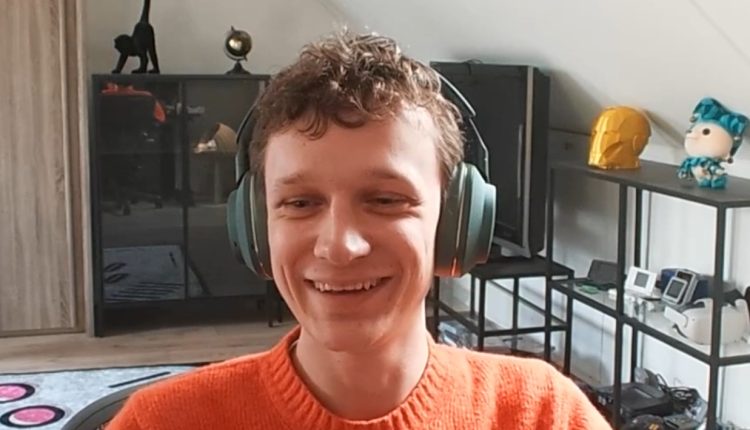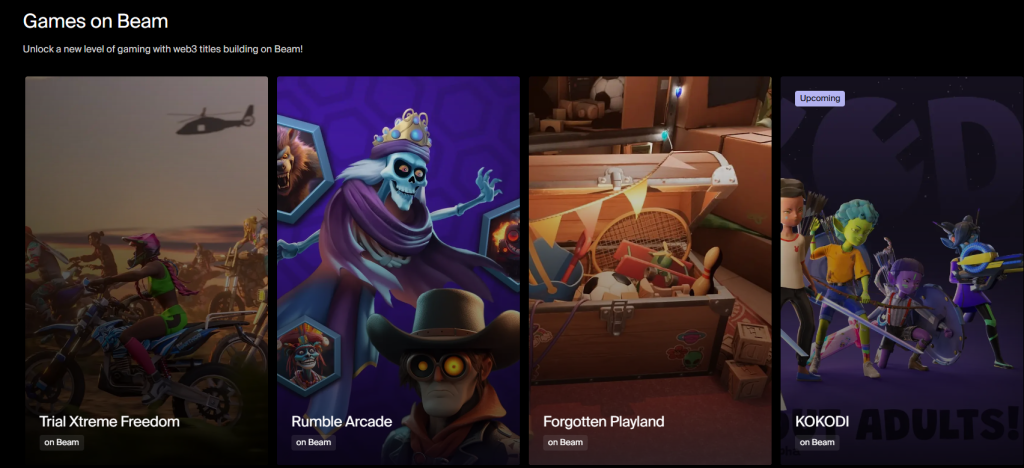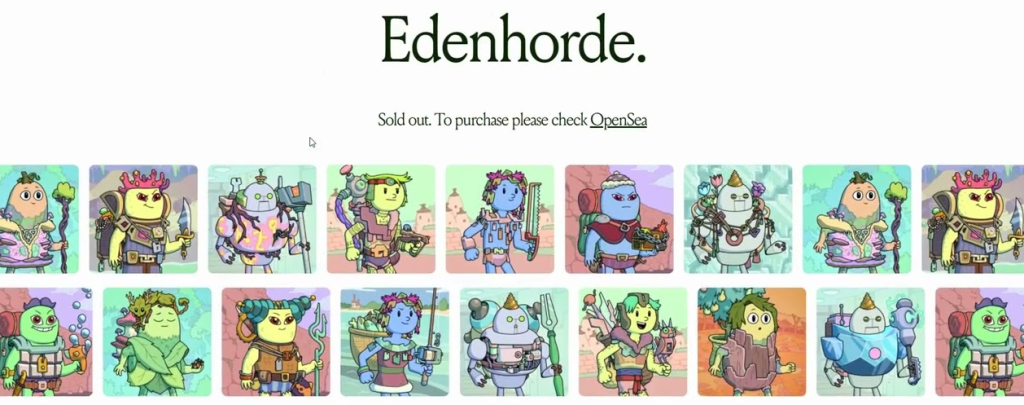How Beam evolved from an Axie guild to a gaming infra and investment powerhouse

In the latest episode of the Blockchain Gaming World podcast, editor-in-chief Jon Jordan talks to Marco van den Heuvel, the co-founder and CGO of Beam, about its genesis from an Axie Infinity guild into a gaming investment DAO and now its current position as the core team behind the Beam gaming blockchain.
BlockchainGamer.biz: How did you get into blockchain?
Marco van den Heuvel: I got into Bitcoin early 2017, so right before one of the bigger bull runs. I just got fascinated. I’ve always been a gamer and I always say as a gamer you understand digital economies and when learning about Bitcoin, it just felt similar. That obviously translated to also learning about Ethereum and about smart contracts and then early CryptoKitties and gaming, I got more and more involved in the space.
Early 2018, I moved to San Francisco for my studies and I found myself more at blockchain conferences than in school because it felt like this is a massive opportunity. This was also the start of my first company, which was in community management, helping startups educate their users on what they were building and what their token was going to be used for. Then in 2021, Axie Infinity blew up and we started Merit Circle.
We’re still here, still going strong and I’m very excited about everything that’s happening going into 2025. So that’s the journey in a nutshell on a personal level.
Why was Merit Circle originally set up?
It started as a guild. I was pretty early in Axie Infinity and was one of the main breeders. If you’re not familiar with Axie Infinity, you’re like ‘What the hell are you talking about?’ Which is always funny when you talk with people about this. But it got to the point where I started selling Axies to guilds and then at some point I realized ‘Hey, there’s a massive growth curve here and figured why don’t I start using this myself? Why don’t I start a guild? So that happened. We were very early to scale. We scaled very aggressively and that’s when it turned from hobby into something more serious.
But we also saw the opportunity beyond just Axie Infinity. You had Illuvium making waves. You had Star Atlas that became popular. There was this promise of triple-A studios that were going to build massive titles. That’s what fueled the search in web3 gaming back in 2021. Merit Circle actually started right at the peak of Bitcoin at $69k so we actually had the worst moment to start.
But treasury-wise, it came right at the perfect moment. Community-wise, it came right at the perfect moment. So it really fueled what is still here today. The treasury survived really well during the bear market and that just got us to the point where now we think bigger. We were one of the first guilds that started scaling from Axie Infinity into different games because we also realized there’s this massive growth curve, but it relies on continuous demands. And otherwise, it’s a card house that could fall very quickly.

But we did see an opportunity in web3 rather than play-to-earn and that’s where we continue to pave ways, be it on the investment side, be it on working with different studios. The natural fit was also to build infrastructure, and fast forward now to Beam, it’s infra. There’s still the treasury side, and we announced the Beam L1 coming up. We announced the Beam Venture fund coming up in Abu Dhabi.
We announced Beam AI where we also want to start taking steps into AI, which is both a natural fit for gaming but also a way for us to expand our activities beyond just gaming, since web3 gaming is still somewhat experimental if we’re honest. You don’t want to just rely on that. So there were just those natural flows, natural pivots and transitions into where we are today. But it all started with Axie Infinity.
Merit Circle was very early to move away from Axie and have this idea of a gaming treasury. How much of that was luck or timing?
Yeah, it’s a good question. What is luck? I believe luck is a big factor when it comes to a lot of things in life. We were lucky to have started this when Bitcoin was $64k, Illuvium’s token was trading at $2k. YGG was booming. Timewise to launch, it was perfect. But two weeks later, crypto felt like it was in a gutter. Bitcoin went down significantly. Altcoins went down significantly. So, timing was lucky, but to scale was obviously not lucky.
I think when it came to scaling down Axie, it was a lot about following the numbers and that is not necessarily luck. When you are such an active breeder in the environment, and you see sales slowing down, you see a very concentrated number of parties buying the Axies and the majority is starting to sell or not buy anymore, you see liquidity slowly dry up.
Even though it hadn’t reached the peak, we had a really large portfolio in the Axie ecosystem and it didn’t make sense for us to devote more money towards it, because that would be just putting more eggs into the basket. It started to make sense to scale down. And we didn’t scale down 100%, but we did scale down very rapidly, very aggressively, and also with the eyes on wanting to do the same model in Illuvium and Star Atlas. But those games hadn’t launched yet so we hadn’t committed anything financially, given there was no game to play.
In our backgrounds, me and my two co-founders have been active in the crypto industry for years. They’ve been in it longer than I have and they’ve been actively investing in early stages of projects, so that naturally made sense when you have a larger strategy. We wanted to become a big player in web3 gaming, become a big player when it comes to pushing this forward, but doing it in a way that makes sense and is sustainable.
And going back to the luck factor, the treasury survived one of the most brutal bear markets, came out pretty strong and has since increased. Obviously we’re not in too great of a market sentiment right now, but generally speaking, it’s been going pretty well.
You’ve done a lot of game investments. Looking back, do you wish you had done half the number of investments but double the amount of investments into projects you thought were higher quality?
I wouldn’t say it was necessarily spray and pray, but early on when the market was booming and web3 gaming was growing so rapidly, you could look at investments from two standpoints. You could look at it from ‘This is going to be this massive title that’s going to take crypto gaming to the masses. It’s really going to take off’. Or it could be ‘This studio is going to have a good launch, it’s going to do well and during this journey, you can start to take out profits and deploy that elsewhere’.
Because you don’t want to be sitting on a treasury that is solely in stablecoins because then people will be ‘What are you doing?’ You also want to establish a brand. You want to become a name in the industry where people know ‘This is well backed. Merit Circle has a treasury that is devoted towards making web3 gaming grow’.
In hindsight, would we have loved to have done things differently? Yeah, absolutely. I mean, we’re very transparent, be it on the community side, be it on the treasury side, being on the way that we’re thinking we should go forward. Yeah, there are learning lessons, but that’s also part of that journey. I think the same learning lessons applied today when you look at the past two months of market sentiment. There’s learning lessons there too because if you have too much illiquidity, it’s hard to be agile.
At the same time, there’s also higher conviction plays that we do believe are going to do really well in the future and that’s been the massive focus throughout the past two years already. If you look at how many tickets we’ve deployed and what that looks like, I would say the past year, year and a half has been very slow but higher conviction bets. Now in the current state of web3 gaming that makes sense. That’s also where the whole AI side came from with our investment in Aethir for example. We still have the flexibility to move in additional directions as well, because you don’t want all your eggs in one basket. But it also means you take those learning lessons, you start to apply them, and you want to continuously do better.
You’ve previously worked on games like Edenhorde but that seems to be something you’ve moved away from recently?
From day one, we never intended to develop games per se but as we became more involved in web 3 gaming, and you are starting to build infra, you also want a playground where you can test your technology, Edenhorde was a great opportunity for us to not just see what it’s like to launch such a project, figure out how can Beam play a role. It’s the same for our co-launched studio for the game Forgotten Playland, which is basically a Mario Party mini-games title.
But we don’t intend to become a game developer. We do intend to be a leading player when it comes to the infrastructure, making sure that when you take a title like Trial Xtreme – this mobile bike racing game from 2009 – we’ve been working with them from the beginning to figure out, what is that web3 aspect going to look like?

And when you think about a studio that is located in the US, you have to deal with the regulatory side of things. You have to deal with top-notch technology because it is not just a small studio. It’s a big studio with a big title that wants to make sure everything works. It’s a massive opportunity to figure out what is the perfect product suite so that you can take those learning lessons, but also that we can take that improved tech to other studios we’re working with. So it’s all about making a smoother onboarding player experience using web3 where it makes sense rather than overdoing it.
How big a shift was it for Merit Circle to launch Beam as its own gaming blockchain?
It naturally made sense for us. There have been pivots along the way and they always made sense and they fit our product suite. In this case with Beam, part of the rebrand was because people still saw us as this early Axie guild but we hadn’t been doing that for over one and a half years, but when you would knock on certain doors, they would not be interested because they saw you as a guild. Whereas when we rebranded to Beam, we saw a lot of doors open up that didn’t open before simply because of a name change. And ever since we changed the name to Beam and the token to Beam, it’s been really pivotal for our growth.
How does Beam compete with other blockchain in terms of grants etc?
That’s what a lot of blockchains do, right? They throw cash at studios hoping they will build and stay on their chain. That’s something we’ve not been doing. We want to help when it comes to user acquisition, when it comes to exposure, marketing, etc. But we’re very transparent about it. We’re not going to give you cash to build on our chain. And the reason is very simple. If you do that, and let’s say you have a one-year clause, one year from now, you’re going to knock on our door asking for more money.
We want to work with studios that are here for good reasons, for the long run. They’re here because they want to have better technology than they can find elsewhere. I think that mainly comes down to customization and figuring out what the blockchain experience is going to look like in your game.
Another thing is we have the Sphere marketplace, which runs on Immutable zkEVM. Using Avalanche has allowed us to build an ecosystem that’s a playground when it comes to tooling. We can experiment with our tech. We can learn from it, improve on it, but the tech stack is chain-agnostic. That’s why part of it is deployed on Immutable zkEVM. Part of it is going to be deployed on Sophon. We’ve always said, we want to be where the games are and where the gamers are. If we see a chain that wants to work with us, we’re open to work with them.
We don’t want to be living on every chain and spread ourselves too thin but working with Immutable and Sophon has been very nice. It’s very nice to also work with studios on the marketplace side of things. The nice thing when you have a broader product suite is you don’t have to deploy everything on every single chain. With the marketplace, for example, we also generate transaction fees so there’s a lot of flexibility.
We don’t need everyone on our chain. We’re happy to work with you. Obviously we’d love for that to be on our chain because we can work even closer. But on our chain we’d be down to work with you too. That’s the difference I would say from a lot of different blockchains.
What titles using Beam should people be checking out?
Depending on which country you’re in, I would say Trial Xtreme Freedom. This new title in the bike racing series is really fun. It’s been one of the few web3 games where I actually find myself playing every evening and going back to it naturally. With a lot of web3 titles, I would play them for a few days and then naturally it fades away.
I’m a bit biased but Forgotten Playland is now live on the Epic Games Store. It’s a Mario Party-style game. It’s a really fun game that people should check out. There’s Rumble Arcade, which is one of the favorites among our team. It’s a very casual game on PC and mobile. Basically it’s a squad builder in which you fight against shadow players. So real players build a squad but they don’t have to be online to fight against you because it’s an auto-battler.
It’s a really nice experience, because a lot of web3 titles struggle when it comes to online gameplay because there aren’t a lot of players online. But with this shadow player tactic where people don’t have to be online at the time you fight them, that’s a really nice fit.
People can also check out hub.onbeam.com. You’ll be able to find any game that is building on Beam.
Finally, what’s the situation with the Beam Venture fund that’s based in Abu Dhabi?
We’ve announced it. We put out some Medium posts. But the fundraising hasn’t happened yet. We’re dealing with the regulatory side of things, which takes time. You have to get a license. A large portion of that is done. It’s just a matter of a lot of paperwork and details that are to be arranged. We intend for that all to happen in 2025. We’ll see how soon that is.
As part of this, there’s also going to be an accelerator program. Abu Dhabi right now is seeing a lot of growth when it comes to attracting talent. There’s a lot of web3-curious studios that are already building a title, have already built a title, are looking into how they can add web3 elements. It’s very nice for us to be the first ones to be doing this there. We’re not looking to work with tens of studios per year. It’s rather going to be a smaller number that we can learn from and hopefully get them to work with Beam on the tech side too.
Find out more at the Beam website.

Comments are closed.